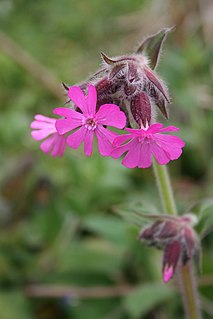
Silene is a genus of flowering plants in the family Caryophyllaceae. Containing nearly 900 species, it is the largest genus in the family. Common names include campion and catchfly. Many Silene species are widely distributed, particularly in the northern hemisphere.

Temperate grasslands, savannas, and shrublands is a terrestrial biome defined by the World Wide Fund for Nature. The predominant vegetation in this biome consists of grass and/or shrubs. The climate is temperate and ranges from semi-arid to semi-humid. The habitat type differs from tropical grasslands in the annual temperature regime as well as the types of species found here.

A wildflower is a flower that grows in the wild, meaning it was not intentionally seeded or planted. The term implies that the plant probably is neither a hybrid nor a selected cultivar that is in any way different from the way it appears in the wild as a native plant, even if it is growing where it would not naturally. The term can refer to the flowering plant as a whole, even when not in bloom, and not just the flower.
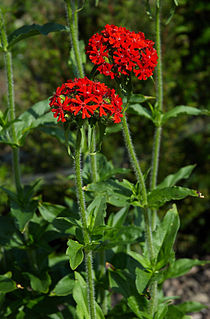
Silene chalcedonica, the Maltese-cross or scarlet lychnis, is a species of flowering plant in the family Caryophyllaceae, native to central and eastern Russia, Kazakhstan, Mongolia and northwestern China. Other common names include flower of Bristol, Jerusalem cross and nonesuch.

Silene acaulis, known as moss campion or cushion pink, is a small mountain-dwelling wildflower that is common all over the high arctic and tundra in the higher mountains of Eurasia and North America,. It is an evergreen perennial flowering plant in the carnation family Caryophyllaceae.
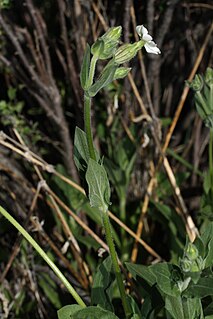
Silene latifolia subsp. alba, the white campion is a dioecious flowering plant in the family Caryophyllaceae, native to most of Europe, Western Asia and Northern Africa. It is a herbaceous annual, occasionally biennial or a short-lived perennial plant, growing to between 40–80 centimetres tall. It is also known in the US as bladder campion but should not be confused with Silene vulgaris, which is more generally called bladder campion.

Silene dioica, known as red campion and red catchfly, is a herbaceous flowering plant in the family Caryophyllaceae, native throughout central, western and northern Europe, and locally in southern Europe. It has been introduced in Iceland, Canada, the US, and Argentina.
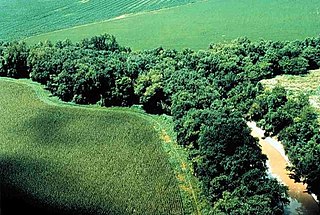
A riparian zone or riparian area is the interface between land and a river or stream. Riparian is also the proper nomenclature for one of the terrestrial biomes of the Earth. Plant habitats and communities along the river margins and banks are called riparian vegetation, characterized by hydrophilic plants. Riparian zones are important in ecology, environmental resource management, and civil engineering because of their role in soil conservation, their habitat biodiversity, and the influence they have on fauna and aquatic ecosystems, including grasslands, woodlands, wetlands, or even non-vegetative areas. In some regions, the terms riparian woodland, riparian forest, riparian buffer zone,riparian corridor, and riparian strip are used to characterize a riparian zone. The word riparian is derived from Latin ripa, meaning "river bank".

Silene vulgaris, the bladder campion or maidenstears, is a plant species of the genus Silene of the family Caryophyllaceae. It is native to Europe, where in some parts it is eaten, but is also widespread in North America, where it is a common wildflower in meadows, open woods, and fields.

Silene undulata is a plant native to the Eastern Cape of South Africa.

Lonicera tatarica is a species of honeysuckle known by the common name Tatarian honeysuckle. It is native to Siberia and other parts of eastern Asia Lonicera tatarica is also known to grow in the Himalayas, however it is better known in North America as a widespread introduced species and noxious weed. Honeysuckles are native to temperate zones of both hemispheres. This plant, one of several exotic bush honeysuckles present in North America, was introduced as an ornamental plant in 1752. It is known across the continent west to Alaska and California, where it easily grows in disturbed habitat.
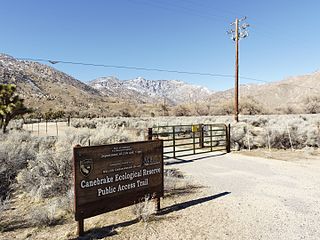
Canebrake Ecological Reserve is a 6,700-acre (27 km2) nature reserve in the South Fork Valley of Kern County, 20 miles (32 km) east of Lake Isabella, California. It is located in the Southern Sierra Nevada region.

Riparian-zone restoration is the ecological restoration of riparian-zonehabitats of streams, rivers, springs, lakes, floodplains, and other hydrologic ecologies. A riparian zone or riparian area is the interface between land and a river or stream. Riparian is also the proper nomenclature for one of the fifteen terrestrial biomes of the earth; the habitats of plant and animal communities along the margins and river banks are called riparian vegetation, characterized by Aquatic plants and animals that favor them. Riparian zones are significant in ecology, environmental management, and civil engineering because of their role in soil conservation, their habitat biodiversity, and the influence they have on fauna and aquatic ecosystems, including grassland, woodland, wetland or sub-surface features such as water tables. In some regions the terms riparian woodland, riparian forest, riparian buffer zone, or riparian strip are used to characterize a riparian zone.

Silene douglasii is a species of flowering plant in the family Caryophyllaceae known by the common name Douglas's catchfly.

Silene occidentalis is a species of flowering plant in the family Caryophyllaceae known by the common names western catchfly and western campion.
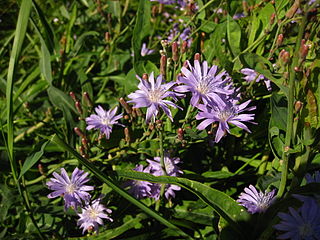
Lactuca tatarica, known as blue lettuce, is a Eurasian flowering plant in the tribe Cichorieae within the family Asteraceae. It is widespread across much of Europe and Asia.

Silene uniflora is a species of flowering plant in the family Caryophyllaceae known by the common name sea campion.

Silene conica is a species of flowering plant in the family Caryophyllaceae known by the common names striped corn catchfly and sand catchfly. It grows in dunes and sandy soils and is widespread in Europe and western Asia. It has an annual life history and produces self-compatible hermaphroditic flowers and occasional male-sterile flowers. Like other members of Silene section Conoimorpha, S. conica is readily recognizable based on its bright pink petals and the prominent, parallel veins on its calyx. In contrast to most flowering plants, S. conica appears to have a very rapid rate of mitochondrial mutation, and has the largest mitochondrial genome ever identified.

Lonicera × bella, known as Bell's honeysuckle and showy fly honeysuckle, is a hybrid species of flowering plant in the family Caprifoliaceae. It was first described by Hermann Zabel in 1889. Zabel reported that he grew it in cultivation from seeds obtained from a plant of Lonicera morrowii, but that its appearance suggested the influence of L. tatarica. It has escaped from cultivation and become an aggressive invasive species in central and eastern parts of the United States.

Atriplex tatarica is a species of plant belonging to the family Amaranthaceae. Its native range spans a large area of Middle and western Central Asia, Asia Minor, North Africa, and Eastern Europe.




















